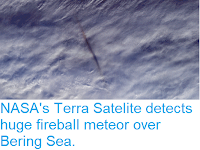The American Meteor Society has
received reports of a bright fireball meteor being seen over the southern New Jersey, slightly before 11.00 pm on Tuesday 16 April 2019 Eastern Standard Time
(slightly before 3.00 am on Wednesday 17 April GMT). The meteor was
also seen from Washington DC, Delaware, Maryland, North Carolina, New Jersey, Pennsylvania, South Carolina, Virginia and West Virginia, with the majority of
the reports came from Maryland. A
fireball
is defined
as a meteor
(shooting star) brighter than the
planet Venus. These are typically caused by pieces of rock burning up in
the atmosphere, but can be the result of man-made space-junk burning up
on re-entry.
The 16 April 2019 meteor seen from Fenwick Island, Delaware. E Kozy/American Meteor Society.
A fireball
is defined
as a meteor
(shooting star) brighter than the
planet Venus. These are typically caused by pieces of rock burning up in
the atmosphere, but can be the result of man-made space-junk burning up
on re-entry. This object appeared to move north-to-south,
passing over New Jersey, and the Atlantic Ocean off the coasts of Delaware and Maryland, where it disappeared. Many witnesses reported that the meteor had a greenish tinge, which is likely to indicate the meteor had a high iron-nickel content.
Map
showing areas where sightings of the meteor were reported, and the
apparent path of the object (blue arrow). American Meteor Society.
Objects
of this size probably enter the Earth's atmosphere several times a
year, though unless they do so over populated areas they are unlikely to
be noticed. They are officially described as fireballs if they produce a
light brighter than the planet Venus. The brightness of a meteor is caused by friction with
the Earth's atmosphere, which is typically far greater than that caused
by simple falling, due to the initial trajectory of the object. Such
objects typically eventually explode in an airburst called by the
friction, causing them to vanish as an luminous object. However this is
not the end of the story as such explosions result in the production of a
number of smaller objects, which fall to the ground under the influence
of gravity (which does not cause the luminescence associated with
friction-induced heating).
The 16 April 2019 meteor seen from Mathius, West Viginia. E Abel/American Meteor Society.
These 'dark objects' do not continue along the path
of the original bolide, but neither do they fall directly to the ground,
but rather follow a course determined by the atmospheric currents
(winds) through which the objects pass. Scientists are able to calculate potential trajectories for hypothetical dark
objects derived from meteors using data from weather monitoring services.
Witness reports can help astronomers to understand these events. If you
witness a fireball-type meteor over the US you can report it to the American Meteor Society here.
See also...
Follow Sciency Thoughts on Facebook.









